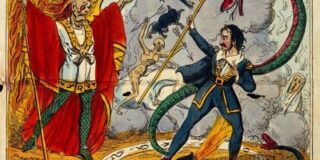
Valentine’s Day: A Sonnet
Upon this day, the earth adorned in light,
Where doves ascend to serenade the sky,
Each heart awakened, freed from winter’s plight,
As tender vows from lover’s lips do fly.
Beneath the boughs where blushing roses bloom,
The sparrow sings his sweet, unyielding tune.
Soft whispers braid amidst the morning’s gloom,
While love reveals her face beneath the moon.
Together, wings unfold in gentle grace,
Each bird, unbound, yet drawn to find its pair.
Beyond the fleeting hours and time’s embrace,
Love lingers, lingering, timeless, rare.
So let this day of hearts and wings remind,
That love is found where souls and fates align.
by Bakchos
Abstract
Valentine’s Day, celebrated on February 14, has become synonymous with romantic love, characterised by the exchange of cards, flowers, and gifts. However, its origins are steeped in a blend of pagan traditions and Christian martyrdom. This paper explores the historical and literary narratives surrounding Valentine’s Day, examining both the pagan roots linked to the Roman festival of Lupercalia and the Christian associations with Saint Valentine. Through an analysis of various sources, including historical texts, religious writings, and literary references, this study aims to provide a balanced understanding of the complex origins of this widely celebrated holiday.
Introduction
Valentine’s Day has evolved into a significant cultural event, celebrated in numerous countries around the world. While its modern manifestation emphasises love and romance, the origins of the holiday are multifaceted, involving both pagan and Christian elements. The interplay between these traditions reflects broader societal changes in the perception of love, morality, and religious influence. This paper will analyse the pagan roots of Valentine’s Day, particularly the Lupercalia festival, and the Christianisation of the holiday through the figure of Saint Valentine. By examining literary quotes and historical evidence, this research will illuminate the dual heritage of Valentine’s Day and its implications for contemporary society.
The Pagan Roots: Lupercalia
The origins of Lupercalia can be traced back to pre-Roman pastoral traditions, where rites aimed at ensuring agricultural and livestock fertility were commonplace. As Rome expanded, Lupercalia absorbed influences from various cultures, evolving into a more elaborate celebration. According to Plutarch, the festival involved the sacrifice of goats and a dog, followed by a ceremonial feast, highlighting its agrarian roots (Plutarch, Moralia). The rituals performed during Lupercalia were believed to invoke the favor of the gods for both human and agricultural fertility.
Ritual Practices and Cultural Significance
The core rituals of Lupercalia included the sacrifice of animals and the subsequent use of their hides by young men, who would run through the streets striking women. This practice, as noted by Plutarch, was intended to promote fertility among women (Plutarch, Moralia). Proponents of the festival argue that these rites served a vital purpose in Roman society, reinforcing community bonds and celebrating fertility as a natural and necessary aspect of life. The festival provided an opportunity for communal engagement and the reaffirmation of social norms surrounding family and reproduction.
The rituals of Lupercalia were characterised by a blend of revelry and mysticism. Young men, known as Luperci, would don the skins of the sacrificed goats and run through the streets, striking women with the hides as a form of blessing for fertility. This practice is poignantly captured in the words of the Roman poet Ovid, who described the festivities in Fasti:
“When the Luperci make their rounds, the women offer themselves, and the young men delight in the festive fun, as they strike with the goat-skin, believing it brings forth life” (Ovid, Fasti, II).
However, the striking of women has drawn criticism, with some scholars arguing that it reflects underlying misogynistic attitudes prevalent in ancient Rome. The act of physically striking women to promote fertility raises ethical concerns about consent and bodily autonomy. Critics contend that such practices contribute to a broader narrative of women’s subjugation within Roman society, undermining the festival’s celebratory aspects.
Additionally, the festival included a lottery system where young men drew the names of women, pairing them for the duration of the festival. This aspect of Lupercalia emphasises the connection between love and fertility, suggesting that the celebration was not solely focused on romantic love but also on procreation and community bonding.
Transition to Christianisation
With the rise of Christianity in the Roman Empire, many pagan festivals were reinterpreted or replaced by Christian observances. By the end of the 5th century, Pope Gelasius I declared February 14 as the feast day of Saint Valentine, thereby associating the day with Christian themes of love and martyrdom.
The Christian Origins: Saint Valentine
Historical Background of Saint Valentine
During the reign of Claudius II, Rome faced numerous military challenges, leading the emperor to conclude that single men were more effective soldiers than those with familial ties. Consequently, he enacted a decree that forbade marriages for young men. This decision reflects the pragmatic approach of Roman leadership, prioritizing military strength over personal liberties. Valentine’s opposition to this decree not only highlights his commitment to love but also serves as a critique of authoritarian governance.
The Martyrdom of Saint Valentine
The most notable account of Saint Valentine’s martyrdom is found in the Passio Sancti Valentini, a hagiographical text that details his trials and execution. According to this text, Valentine continued to perform secret marriages, demonstrating his belief that love transcends the dictates of tyrants. The passage, “For love is the greatest of all virtues, and in the face of tyranny, he chose to unite hearts in holy matrimony,” encapsulates the essence of Valentine’s defiance and his prioritisation of love over conformity.Literary Representations
The figure of Saint Valentine has been immortalised in literature, serving as a symbol of love and sacrifice. Geoffrey Chaucer, in Parliament of Fowls, links the feast of Saint Valentine with the onset of spring and the mating of birds, suggesting a deep connection between the saint and romantic love:
“For this was on Saint Valentine’s day, when every bird cometh there to choose his mate.” (Chaucer, Parliament of Fowls).
Chaucer’s work illustrates the gradual transformation of Valentine’s Day from a pagan celebration of fertility into a day dedicated to romantic love, influenced by Christian ideals.
The Evolution of Love
As Christianity spread, the concept of love began to shift from a primarily physical and procreative understanding to one that emphasised spiritual and emotional connections. The teachings of early Christian theologians, such as Augustine of Hippo, contributed to this transformation by advocating for love as a divine gift. Augustine wrote:
“Love is the beauty of the soul, and it is through love that we come to know God” (Augustine, Confessions).
This evolving definition of love laid the groundwork for the modern celebration of Valentine’s Day, which emphasises emotional bonds and romantic partnerships.
The Synthesis of Traditions
The Merging of Pagan and Christian Elements
The synthesis of pagan and Christian traditions surrounding Valentine’s Day reflects a broader trend in the history of religious practices. As Christianity sought to convert pagan populations, it often adopted and reinterpreted existing customs. The celebration of love and fertility during Lupercalia was seamlessly integrated into the feast of Saint Valentine, creating a holiday that honoured both romantic love and spiritual devotion.
This merging is evident in the customs associated with Valentine’s Day today, which include elements of both the Lupercalia festival—such as the exchange of love tokens—and the Christian emphasis on love as a virtue. The exchange of cards and gifts can be seen as a modern continuation of the ancient practices of honouring love and fertility.
Literary Reflections of the Synthesis
Literary works from various periods further illustrate the evolving nature of Valentine’s Day. In Shakespeare’s Romeo and Juliet, the theme of love is central, encapsulating both the passionate and tragic dimensions of romantic relationships. Juliet’s declaration:
“My only love sprung from my only hate!” (Shakespeare, Romeo and Juliet, I.v.138)
highlights the complexities of love, suggesting that it is both a blessing and a source of conflict. This duality resonates with the historical blending of pagan and Christian ideals surrounding love.
Furthermore, in the 18th century, the poet Samuel Taylor Coleridge reflected on the nature of love in his work The Rime of the Ancient Mariner, where he muses on the spiritual connection between love and the divine:
“He prayeth well, who loveth well, both man and bird and beast; for he prayeth best who loveth best all things both great and small” (Coleridge, The Rime of the Ancient Mariner).
This sentiment aligns with the Christian understanding of love as a reflection of divine grace, further illustrating the enduring impact of Saint Valentine’s legacy.
Conclusion
The origins of Valentine’s Day are a rich tapestry woven from both pagan and Christian traditions. The festival of Lupercalia laid the groundwork for the celebration of love and fertility, while the martyrdom of Saint Valentine provided a moral and spiritual framework that transformed the holiday into a celebration of romantic love. Through literary references and historical accounts, we see the evolution of love from a physical and communal concept to one that emphasizes emotional and spiritual connections.
As Valentine’s Day continues to evolve in contemporary society, it remains a testament to the enduring power of love, drawing from its complex heritage. The interplay between pagan and Christian elements serves as a reminder of the multifaceted nature of human relationships and the ways in which cultural practices can adapt and transform over time.
References
• Augustine of Hippo. Confessions.
• Chaucer, Geoffrey. Parliament of Fowls.
• Coleridge, Samuel Taylor. The Rime of the Ancient Mariner.
• Ovid. Fasti.
• Plutarch. Moralia.
• Passio Sancti Valentini.


